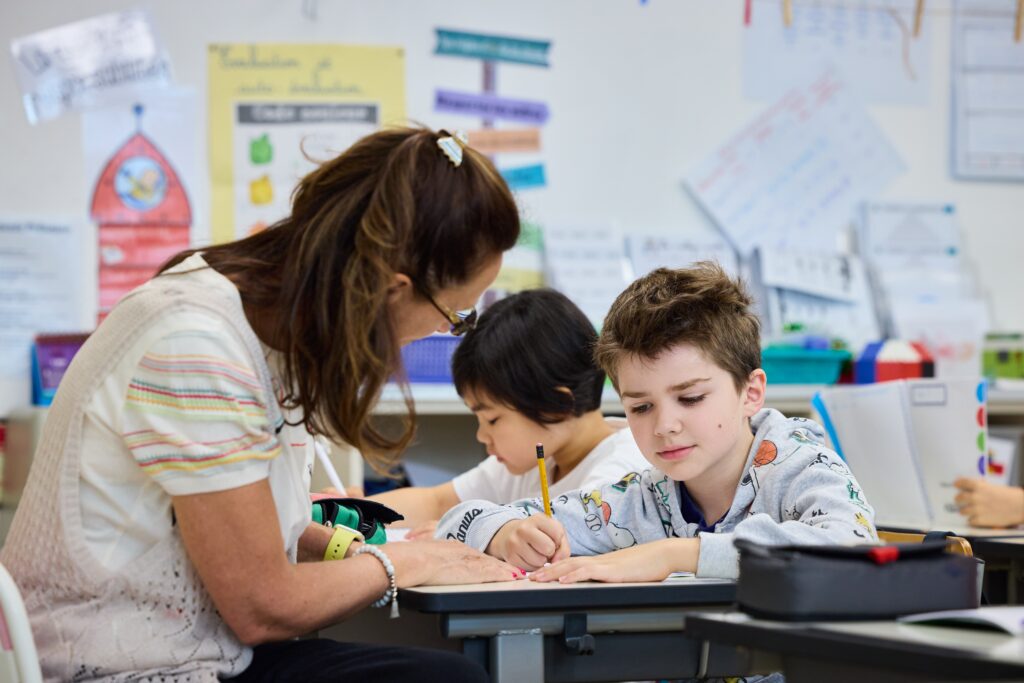BarometerCegos Transformations, Skills and Learning” 2025 reveals that 40% of directors and human resources managers experience difficulty aligning their organization’s skills needs with training offerings. As for employees, 41% believe that the company’s training response comes too late in meeting their needs. Collaborative learning provides a relevant response to these issues. It refers to employee learning through contact with peers, which tends to continuously strengthen skills as closely as possible to individual expectations.

What is collaborative learning?
The definition of collaborative learning can be summed up in a few words: learning with and thanks to others . It is a learning method that focuses on the contribution of each individual to the group. Collaborative learning is based on the pooling of knowledge, expertise, and practices, for a regular improvement in the skills of all . In French, we speak of collaborative learning.
We note in this pedagogical approach
- in interdependence between learners
- strengthening teamwork
- an apprenticeship that breaks with the verticality of traditional methods
Be careful not to confuse collaborative learning with cooperative learning! The latter refers to the creation of small, heterogeneous groups that work together to complete a specific task. This is a pedagogical model that is more suited to the world of education than the professional world. Furthermore, this model is limited to practical work. Collaborative learning, on the other hand, refers to a comprehensive method that is deployed without time constraints and is not limited to certain activities.
The benefits of collaborative learning for teams
A decentralized system
The fundamental principle of collaborative learning is the provision of training content by employees themselves, the recipients being simply their colleagues. This peer-to-peer system is described as decentralized since the learning is 100% horizontal. Employees are placed on an equal footing: everyone is both a “knower” and a “learner.” Each talent is encouraged to contribute their knowledge and expertise to the company. To this end, Rise Up has set up a tool dedicated to user-generated content, which allows employees to easily design training modules based on their knowledge directly on their LMS. Administrators, by activating a review option, can review the content before publication.
This approach to training strengthens learner engagement because it values skills and stimulates learning.
Learning communities to strengthen team spirit
Collaborative learning humanizes training, especially distance learning. This teaching method breaks with the isolation, more or less significant, caused by learning. The latter leads the employee to learn alone, often passively. Collaborative learning goes hand in hand with the creation of communities of learners, within which members exchange, share resources and best practices, communicate about their experiences, and, in short, learn from each other. Via a dedicated platform, it is easy and natural to interact (just post comments or reactions, for example). Result: the social bond is maintained, even strengthened, and the learner becomes active by participating in the development of his colleagues’ skills.
Learning groups transcend departments and hierarchy. The training work carried out within them strengthens team spirit and collective intelligence, while imbuing the company with alearning-oriented culture.
Flexible and agile training
Characterized by exchanges between talents, collaborative learning relies on a flexible and manageable structure. Training content evolves at the pace of work, in line with business challenges and needs. Designed in a few hours, updated in a few minutes by employees on the LMS, this material is truly alive, in addition to being accessible to all employees. Collaborative learning continues with discussions via collaborative tools, during slots chosen by the various learners and the internal expert concerned.
Among the advantages of collaborative learning are flexibility and agility. Employees create and learn, in turn, at the most convenient times and for durations that suit them.
Training managers and HR teams play a facilitating role here. They must stimulate this collaborative learning dynamic, for example, by adding gamification to the module creation process by employees (who then receive a reward).
Savings on training
Collaborative learning requires little investment. It involves the use of a room available on the company’s premises and/or collaborative tools (communication applications in particular, file sharing software), which employees already benefit from in their work. As for learning resources, they consist primarily of the knowledge of internal experts, who enrich them with selected elements from the Internet (blog articles, podcasts, etc.). Furthermore, there is no need for an external trainer or an educational engineer, which guarantees not only substantial savings but also significant time savings.
How can the implementation of collaborative learning within an organization be promoted?
The implementation of collaborative learning must be placed in a broader context, that of collaborative work. Establishing a learning method based on collaboration can be difficult if employees are not used to working in teams, or even across departments, daily. It is also necessary that the management wadoptpractices geared towards the empowerment and accountability of employees. It is also up to the line manager to stimulate and encourage employees to train and share their knowledge.
On a practical level, it is wise to designate a specific person who will be responsible for facilitating the implementation of a collaborative learning action within a group of learners.
Establish a culture of learning.
Becoming a learning organization, in other words, positioning skills acquisition as the driving force behind the company’s activities,: is a prerequisite that greatly facilitates the establishment of innovative teaching methods, such as collaborative learning. Developing a learning culture conditions the mindset of employees, naturally leading them to acquire new reflexes: expanding their knowledge, questioning their “expert” colleagues daily, seeking out relevant sources of information, etc.
This sometimes requires a paradigm shift for companies. Instead of reacting “after the fact,” that is, designing training programs once gaps have been identified, they must instead foster continuous skills growth upstream. One of the keys is to focus on social and human factors, by encouraging employees to strengthen their relationships and contribute to the dissemination of knowledge on a daily basis.
Developing team flexibility
Fixed and repetitive schedules, with a clear separation between time slots dedicated to training and the rest of the workday: a situation that is very poorly suited to the development of collaborative learning. It is indeed the opposite approach that should be adopted. Teams need flexibility and room to maneuver; employees must be given full latitude so that they can organize themselves and insert learning time into their schedules at the most opportune times.
Flexibility also plays a role in another aspect, one that proves strategic for the company: competitiveness. Indeed, the extremely rapid deployment of training results in new agility, a greater ability to adapt to the market. Skills adjust in real time to meet needs, which optimizes team responsiveness.
Focus on the quality of content and memory anchoring
The pitfall of collaborative learning: the lack of framework and control, leading to potentially low-quality and insufficiently structured exchanges. Expert employees sharing their knowledge must prepare high-quality materials and elicit feedback from their peers (for example, by encouraging them to ask questions, make comments, etc.).
When carried out well, collaborative learning actions have advantages that more traditional training methods do not have (or have less of):interactivitybetween colleagues, in a climate that is both professional and friendly, proactive collaborators, both when they create content and when they follow training prepared by their peers. There is a strong sense of accountability among colleagues in collaborative learning, which is not found in e-learning, for example.










